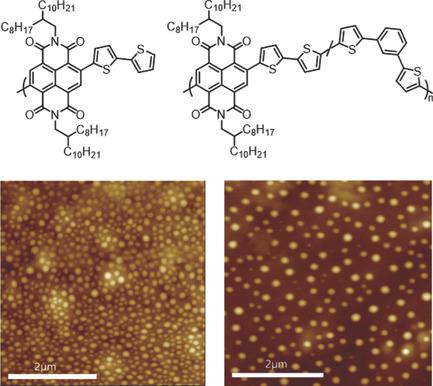当前位置:
X-MOL 学术
›
Adv. Electron. Mater.
›
论文详情
Our official English website, www.x-mol.net, welcomes your feedback! (Note: you will need to create a separate account there.)
Improving Miscibility of a Naphthalene Diimide‐Bithiophene Copolymer with n‐Type Dopants through the Incorporation of “Kinked” Monomers
Advanced Electronic Materials ( IF 6.2 ) Pub Date : 2018-03-12 , DOI: 10.1002/aelm.201700581 Younghun Shin 1 , Matteo Massetti 2, 3 , Hartmut Komber 4 , Till Biskup 5 , Diego Nava 2, 3 , Guglielmo Lanzani 2, 3 , Mario Caironi 2 , Michael Sommer 1
Advanced Electronic Materials ( IF 6.2 ) Pub Date : 2018-03-12 , DOI: 10.1002/aelm.201700581 Younghun Shin 1 , Matteo Massetti 2, 3 , Hartmut Komber 4 , Till Biskup 5 , Diego Nava 2, 3 , Guglielmo Lanzani 2, 3 , Mario Caironi 2 , Michael Sommer 1
Affiliation

|
N‐type doping of polymer semiconductors is necessary to enable printable and efficient organic thermoelectric generators. A recently reported method relies on blending air‐stable benzimidazole derivative dopant molecules with good electron transporting materials, such as the well‐known poly{[N,N′‐bis(2‐octyldodecyl)‐naphthalene‐1,4,5,8‐bis(dicarboximide)‐2,6‐diyl]‐alt‐5,5′‐(2,2′‐bithiophene)}, also known as PNDIT2. One of the main limitations to doping efficiency is miscibility of the dopant with the polymer. In order to overcome such limitation, controlled amounts of the covalently incorporated, meta‐substituted monomer 1,3‐bis(2‐thienyl)benzene (TPT) (“kinked monomer”) are introduced into the otherwise straight backbone of PNDIT2. Differential scanning calorimetry shows that crystallinity of P(NDI‐alt‐[T2‐co‐TPT]) first decreases with increasing TPT content up to 5 mol%, but then increases again for higher TPT contents. Miscibility of P(NDI‐alt‐[T2‐co‐TPT]) with the dopant 4‐(1,3‐dimethyl‐2,3‐dihydro‐1H‐benzoimidazol‐2‐yl)‐N,N‐diphenylaniline increases with increasing TPT content up to 30 mol%. The electrical conductivity of doped P(NDI‐alt‐[T2‐co‐TPT]) films is reduced with respect to PNDIT2, owing to a lower charge mobility caused by TPT units which break conjugation. Nevertheless, the doping efficiency at high doping concentration is substantially improved, with an estimated ≈20‐fold increase with respect to PNDIT2, as a result of the improved miscibility of dopant and copolymer.
中文翻译:

通过掺入“扭结”单体,提高带有n型掺杂剂的萘二酰亚胺-联噻吩共聚物的混溶性
N型掺杂聚合物半导体对于实现可印刷且高效的有机热电发生器是必不可少的。最近报道的一种方法依赖于将空气稳定的苯并咪唑衍生物掺杂剂分子与良好的电子传输材料混合,例如众所周知的聚{[ N,N'-双(2-辛基十二烷基)-萘-1,4,5,8双(二甲酰亚胺)-2,6-二基] - ALT -5,5' - (2,2'-联噻吩)},也称为PNDIT2。掺杂效率的主要限制之一是掺杂剂与聚合物的混溶性。为了克服这种限制,控制量的共价结合的间位将预取代的单体1,3-双(2-噻吩基)苯(TPT)(“扭结的单体”)引入到PNDIT2的否则笔直的骨架中。差示扫描量热表明,P的结晶性(NDI- ALT - [T2-共-TPT])第一随TPT含量高达5摩尔%的降低,但随后对更高TPT内容再次增加。P的混溶性(NDI- ALT - [T2-共-TPT])与掺杂剂的4-(1,3-二甲基-2,3-二氢- 1 H ^ -苯并咪唑-2-基) - ñ,Ñ -diphenylaniline增加TPT含量增加到30 mol%。p掺杂的电导率(NDI- ALT - [T2-共‐TPT])薄膜相对于PNDIT2减少了,这是因为由TPT单元破坏了共轭作用而导致的电荷迁移率较低。然而,由于掺杂剂和共聚物的混溶性提高,因此在高掺杂浓度下的掺杂效率得到了显着提高,相对于PNDIT2估计提高了约20倍。
更新日期:2018-03-12
中文翻译:

通过掺入“扭结”单体,提高带有n型掺杂剂的萘二酰亚胺-联噻吩共聚物的混溶性
N型掺杂聚合物半导体对于实现可印刷且高效的有机热电发生器是必不可少的。最近报道的一种方法依赖于将空气稳定的苯并咪唑衍生物掺杂剂分子与良好的电子传输材料混合,例如众所周知的聚{[ N,N'-双(2-辛基十二烷基)-萘-1,4,5,8双(二甲酰亚胺)-2,6-二基] - ALT -5,5' - (2,2'-联噻吩)},也称为PNDIT2。掺杂效率的主要限制之一是掺杂剂与聚合物的混溶性。为了克服这种限制,控制量的共价结合的间位将预取代的单体1,3-双(2-噻吩基)苯(TPT)(“扭结的单体”)引入到PNDIT2的否则笔直的骨架中。差示扫描量热表明,P的结晶性(NDI- ALT - [T2-共-TPT])第一随TPT含量高达5摩尔%的降低,但随后对更高TPT内容再次增加。P的混溶性(NDI- ALT - [T2-共-TPT])与掺杂剂的4-(1,3-二甲基-2,3-二氢- 1 H ^ -苯并咪唑-2-基) - ñ,Ñ -diphenylaniline增加TPT含量增加到30 mol%。p掺杂的电导率(NDI- ALT - [T2-共‐TPT])薄膜相对于PNDIT2减少了,这是因为由TPT单元破坏了共轭作用而导致的电荷迁移率较低。然而,由于掺杂剂和共聚物的混溶性提高,因此在高掺杂浓度下的掺杂效率得到了显着提高,相对于PNDIT2估计提高了约20倍。


























 京公网安备 11010802027423号
京公网安备 11010802027423号